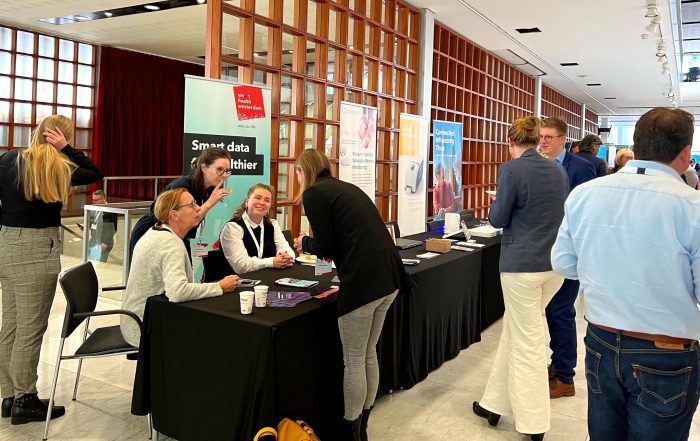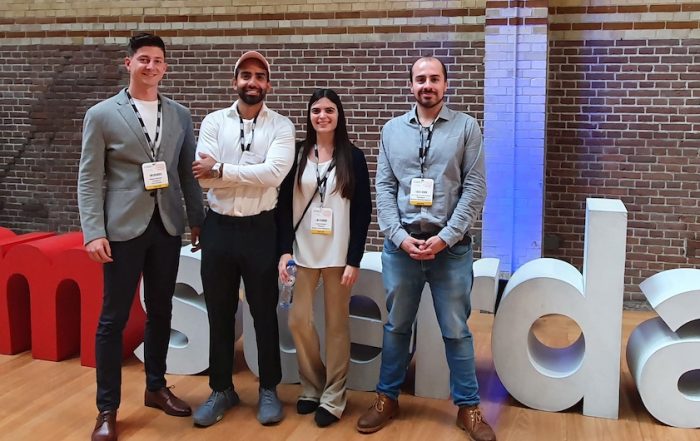Maurice van den Bosch (OLVG) on innovation in healthcare
Digital solutions, data science, AI-driven innovation – they’re hot topics in smart health circles. But among the general public, there’s still a lack of understanding and patients worry that AI will replace the human touch by a robot.
OLVG, Amsterdam’s leading clinical hospital, plays a pioneering role in applying new tech and digital healthcare solutions. CEO Maurice van den Bosch is on a mission to build trust and share the benefits of innovation with as many people as possible – both patients and fellow healthcare professionals.
Curiosity and creativity
Van den Bosch is convinced that data science and AI innovations can make healthcare more accessible and improve people’s well-being and quality of life. According to him, the challenges of dealing with the COVID-19 pandemic have highlighted the need for a transformation of healthcare. They have also accelerated the development of digital solutions. And, he says, that’s one of the reasons he was happy to take on the running of the OLVG. “The OLVG staff have curiosity in their DNA,” he says. “Many of them are entrepreneurs. They invent things. I would use the word creative. The leadership team, the nurses, the specialists, they try to find new solutions.”
Stepping out of the comfort zone
In 2019, Van den Bosch and his team developed the OLVG ‘Close to You’ strategy, which, he says, is about “stepping out your own comfort zone and building a bridge towards the healthcare of patients at home.” As part of this strategy, the hospital has introduced a new platform for electronic medical records. Van den Bosch describes it as “an app environment” to on-board patients coming to the hospital. Over 200,000 people are now using the system. It allows them to make appointments, schedule treatments and share the results of diagnostic tests.
Building the Virtual Ward
OLVG’s second major digital programme broadens this focus on the relationship between hospital and patients, applying it to all care within the Amsterdam region. The Virtual Ward is a partnership between general practitioners, Cordaan (a long-term care organisation) and Zilveren Kruis (a major health insurance company). The Virtual Ward aims to improve care for chronic patients outside the hospital environment, without increasing the burden on GPs and caregivers. A digital platform and remote monitoring system allow GPs, long-term care workers and OLVG staff to collaborate on advising patients and ensuring their safety.
Major breakthrough for patients
The ambition now is to scale up the Virtual Ward to a national level. Van den Bosch is a driving force behind a nationwide project called Santeon, a network of seven top clinical medical centres in the Netherlands, driven by the principle of value-based healthcare. This year, Santeon launched the Santeon at Home programme with the aim of redesigning the Virtual Ward for use by all the participating medical centres. “If we can come up with a common language, and share data that allows analysis and building of algorithms – would that not be a major breakthrough for patients?” Santeon at Home is under development and Van den Bosch hopes it’ll be going live by the end of the year.
A hybrid system
Not everyone is comfortable with digital innovation in the healthcare sector. Van den Bosch strongly feels it’s important to address any anxieties around a potential loss of face-to-face contact between patient and caregiver. Digital solutions are needed to keep the healthcare system accessible, he says, but trust must be built in a hybrid system. “We will still have nurses and physicians in place in hospitals. There will be moments and there are diseases where you want to see your caregiver and look each other in the eye.”
The field of chronic diseases is, he thinks, an ideal proving ground for new healthcare delivery models, as sufferers tend to have high levels of knowledge when it comes to self-care and are living with their condition outside a hospital environment. During the pandemic, some 50% of physical chronic care consultations shifted to the digital sphere. And that is still the case because, as Van den Bosch observes, it’s what many patients prefer.
“We discuss this a lot among colleagues, but we need to bring in the voice of the patients. They are asking for solutions that are friendly. It’s more and more convenient when things can be done digitally.”
Pressure to deliver
A recent article (in Dutch) by the entrepreneurs’ organisation VNO-NCW suggested that a conservative medical sector was getting in the way of innovation. Van den Bosch thinks the criticism is unjustified. While agreeing that more change is needed, he points to the incredible pressure the healthcare system has been under during the COVID-19 pandemic. He believes nurses and physicians are highly motivated to improve patient care and are willing to change the ways they work. But in the face of sustained pressure and staff shortages, that’s easier said than done. “People have been under tremendous stress for more than two years; we have to keep in mind the pressure to deliver under our existing systems,” he says, adding that it’s easy to say what people should do from the side-lines, but it’s important to understand the system itself and how change comes about.
Opening the windows
Innovation, says Van den Bosch, can’t be forced. Fresh solutions are often found outside the established systems but change needs to happen from the inside out. Van den Bosch has previously said that “innovation happens when the windows are open”, and it’s a particularly apt metaphor for hospitals where the windows are usually closed. Look outside, he says – “look how people are getting their shopping done, ordering their books, arranging their travel. It’s all being done on a phone. Don’t think that these same citizens believe healthcare can stay the same for the next 10 years. It’s impossible.”
‘Opening the windows’ also means bringing in solutions, best practices and new ways of working that emerge from external companies and hospitals in other countries. “When I look at digital transformation, we could increase the pace if we would be willing to share more and learn from each other.”
Tackling innovation bottlenecks
Rather than healthcare providers’ unwillingness to change, innovation is being hampered by a number of other factors, according to Van den Bosch. The first of these is a lack of patient trust in private company involvement in healthcare. “Patients trust hospitals, that’s why we have had the system in place for so long. If you look at healthcare, patients are less likely to trust tech companies, because they are concerned about the safety of their data. So, I think we need to build new partnerships with tech companies and address the trust issue.”
Another important – and rarely discussed – factor is financial incentive. The income of hospitals and healthcare professionals is based on seeing and treating patients. So, says Van den Bosch, “if we come up with a successful digital solution or innovation that is keeping patients outside the hospital, we will become very poor. That is not a sustainable economic model.” The solution is in getting health insurance companies on board with a new reimbursement system. “If you keep supplying money only for diagnosing and treating people, and I’m shifting towards keeping people healthy, then I’m shooting myself in the foot. We need to come up with new methods that reflect population-based health management. A fee, for example, for all the people we keep healthy and out of the hospital.”
The third crucial factor, according to Van den Bosch, is leadership. “It’s not only about digital transformation – transforming your own company, getting people aligned and involved, requires leadership. Are you willing and trying to work with other companies, tech companies? Are you collaborating with the community? Are you able to bring in the insurance companies?” Without clear leadership, innovation will not happen. “You need to have it as your goal to bring change.”
Collaboration is key
One of the factors driving progress at the OLVG is Amsterdam’s thriving innovation ecosystem, which encourages collaboration. “I think Amsterdam is lucky to have a lot of startups,” says Van den Bosch. Amsterdam Economic Board’s initiative Smart Health Amsterdam is connecting people and organisations around innovative themes in the Life Sciences & Health sector. “Within Smart Health Amsterdam, many of the people in charge of a startup are meeting people like me, who are on the board of a larger company. So it’s easier to start collaborations.” And those collaborations are every bit as important as technological advances: “Transformation, in the end, is the work of people. We need to know each other, trust each other and work together. If you look at digital transformation, it’s perhaps even more important than the performance of a company itself. Do people match? Are they interested? Are they willing to share? And that is the beauty of Smart Health Amsterdam. They are about bringing people together and sharing ideas and finding new partnerships. That’s why it’s so very exciting to work in Amsterdam.”
Find more articles in this series at the website of Smart Health Amsterdam.
20 May 2022
Read more about
Contact us
Want to keep up to date?
Get the best regional news and events (in Dutch) via the Board Update newsletter
Share this news
Want to keep informed?
Follow us daily on LinkedIn and sign up for the Board Update newsletter.
Read more
- What AI applications are we already deploying for healthcare and wellbeing? What ...
- Adyen is one of the great success stories of Amsterdam’s tech ...
- Together with enthusiastic partners in three coalitions, the Amsterdam Economic Board is ...




